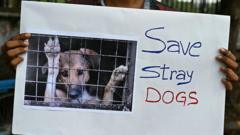In a controversial decision, the Tiergarten Nürnberg zoo in southern Germany has culled 12 healthy Guinea baboons, citing overcrowding as the primary reason. The culled baboons were subsequently fed to predators. This action has ignited widespread protests, resulting in the arrest of seven animal rights activists who entered the zoo to demonstrate against the culling. Among them, a woman was reported to have glued her hands to the ground near the entrance.
According to the zoo, overcrowding had led to an "increase in conflicts" among the baboon population, which had exceeded 40—significantly over the 25 that its enclosure, completed in 2009, was designed to accommodate. The zoo claimed that previous attempts to control the population through contraception were unsuccessful and that alternative housing solutions were not available.
Animal welfare advocates, however, are challenging the justification for killing the baboons. Christoph Maisack, head of the German Legal Association for Animal Protection Law, argued that breeding irresponsibly cannot justify lethal actions against healthy animals. Animal rights groups have filed criminal complaints against the zoo, asserting that the decision to cull was "avoidable and illegal" and was a result of neglectful breeding practices.
Zoo director Dag Encke stated that the choice to cull the baboons was made after "years of consideration" and emphasized that such actions are occasionally necessary for population preservation. He pointed out that the culling complied with standards set by the European Association of Zoos and Aquaria (EAZA), suggesting that it was a last resort.
Culling has historically drawn criticism across European zoos; in 2014, a similar incident sparked outrage when a Copenhagen zoo euthanized a giraffe named Marius for genetic reasons, and the carcass was publicly dissected for feeding lions. The culling of these Guinea baboons has reignited debates about ethical treatment and management of animal populations in captivity.





















